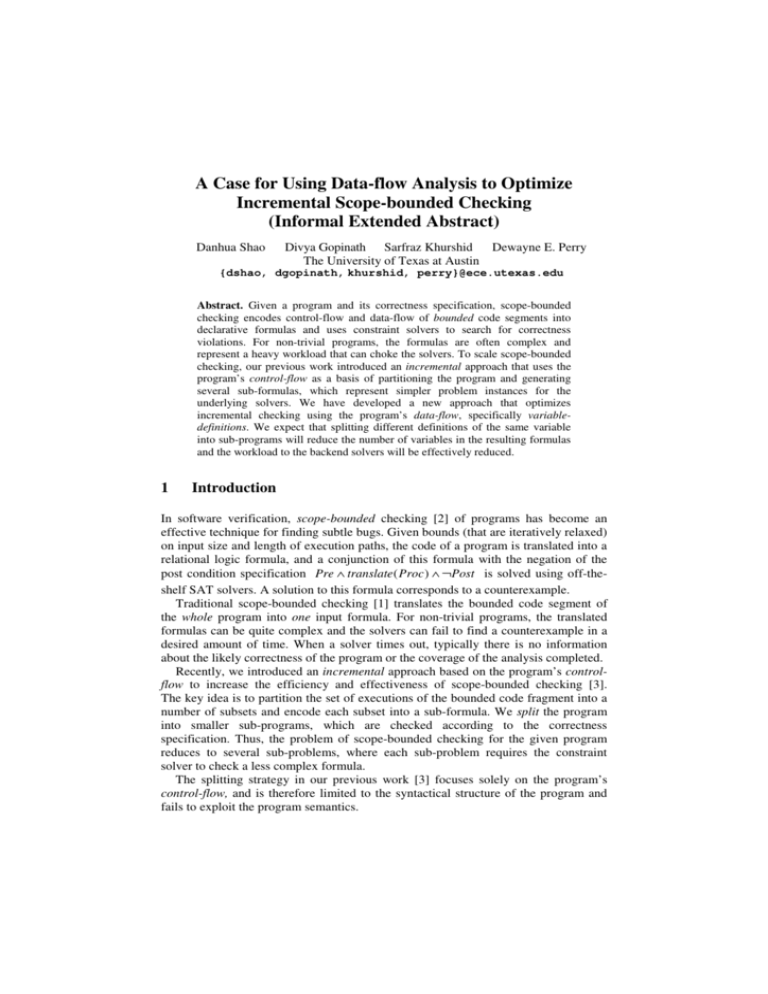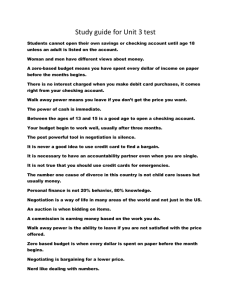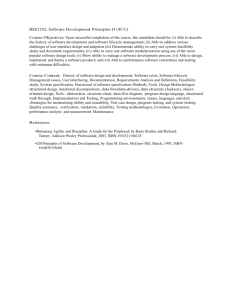A Case for Using Data-flow Analysis to Optimize Incremental Scope
advertisement

A Case for Using Data-flow Analysis to Optimize
Incremental Scope-bounded Checking
(Informal Extended Abstract)
Danhua Shao
Divya Gopinath Sarfraz Khurshid
The University of Texas at Austin
Dewayne E. Perry
{dshao, dgopinath, khurshid, perry}@ece.utexas.edu
Abstract. Given a program and its correctness specification, scope-bounded
checking encodes control-flow and data-flow of bounded code segments into
declarative formulas and uses constraint solvers to search for correctness
violations. For non-trivial programs, the formulas are often complex and
represent a heavy workload that can choke the solvers. To scale scope-bounded
checking, our previous work introduced an incremental approach that uses the
program’s control-flow as a basis of partitioning the program and generating
several sub-formulas, which represent simpler problem instances for the
underlying solvers. We have developed a new approach that optimizes
incremental checking using the program’s data-flow, specifically variabledefinitions. We expect that splitting different definitions of the same variable
into sub-programs will reduce the number of variables in the resulting formulas
and the workload to the backend solvers will be effectively reduced.
1
Introduction
In software verification, scope-bounded checking [2] of programs has become an
effective technique for finding subtle bugs. Given bounds (that are iteratively relaxed)
on input size and length of execution paths, the code of a program is translated into a
relational logic formula, and a conjunction of this formula with the negation of the
post condition specification Pre ∧ translate ( Proc ) ∧ ¬Post is solved using off-theshelf SAT solvers. A solution to this formula corresponds to a counterexample.
Traditional scope-bounded checking [1] translates the bounded code segment of
the whole program into one input formula. For non-trivial programs, the translated
formulas can be quite complex and the solvers can fail to find a counterexample in a
desired amount of time. When a solver times out, typically there is no information
about the likely correctness of the program or the coverage of the analysis completed.
Recently, we introduced an incremental approach based on the program’s controlflow to increase the efficiency and effectiveness of scope-bounded checking [3].
The key idea is to partition the set of executions of the bounded code fragment into a
number of subsets and encode each subset into a sub-formula. We split the program
into smaller sub-programs, which are checked according to the correctness
specification. Thus, the problem of scope-bounded checking for the given program
reduces to several sub-problems, where each sub-problem requires the constraint
solver to check a less complex formula.
The splitting strategy in our previous work [3] focuses solely on the program’s
control-flow, and is therefore limited to the syntactical structure of the program and
fails to exploit the program semantics.
(a)
(b)
Figure 1. Class IntList (contains() method and an instance).
Since the complexity of the formulas comes from both the data-flow and the
control-flow, we hypothesize that the use of data-flow in defining splitting strategies
is likely to further reduce the workload of the constraint solvers. We introduce a
splitting strategy based on variable-definitions. Specifically, we split the program
based on different definitions of the same variable into sub-programs, which leads to
a reduction in the number of variables in the resulting sub-formulas. The rationale
behind this is that decrease in the number of definitions for a variable would reduce
the number of intermediate variable names and thus the number of frame conditions
introduced in data flow encoding.
2
Example
Suppose we want to check the contains() method of class IntList (Figure 1 (a)).
An object of IntList represents a singly-linked list. The header field points to
the first node in the list. Objects of the inner class Entry represent list nodes. The
value field represents the (primitive) integer data in a node. The next field points to
the next node in the list. Figure 1 (b) shows an instance of IntList.
Consider checking the method contains() of class IntList. Assume a
bound on execution length is one loop unrolling. Figure 2(a) shows the program and
its computation graph [2] for this bound.
Our program splitting strategy is variable-definition based. Given a variable in the
computation graph, we split the graph into multiple sub-graphs such that each subgraph has at most one definition for the variable ,that can reach the exit statement.The
definition of this variable in each sub-graph is different.
In Figure 2 (a), the definition of variable this and key is empty set {}. Definitions
of variable return is statement set {4, 8, 11}, and definition of variable e is statement
set {1, 5, 9}. All of these definitions can reach the exit statement.
Suppose we select definitions of variable e (the most modified variable) to split the
computation graph, we construct three sub-programs: Figure 2(b), 2(c), and 2(d).
Each sub-program only contains one definition of variable e.
3
Summary
Scalability is a key challenge for scope-bounded checking. For non-trivial programs,
the formulas translated from control-flow and data-flow can be quite complex and the
public boolean
constains(int key)
{
1 : Entry e = this.header;
2 : if (e != null){
3 : if (e.value == key){
4 :
return true;
}
5 : e = e.next;
6 : if (e != null){
if (e.value == key){
7 :
8 :
return true;
}
9 :
e = e.next;
}
10: assume(e == null);
}
11: return false;
0 :}
(a)
public boolean
sub1(int key)
{
1 : Entry e = this.header;
2 : if (e != null){
3’: assume (e.value==key)
4 :
return true;
public boolean
sub2(int key)
{
1 : Entry e = this.header;
2’: assume (e != null);
3”: assume !(e.value==key);
4 :
public boolean
sub3(int key)
{
1 : Entry e = this.header;
2’: assume(e != null);
3”: assume !(e.value==key);
4 :
5
6
7
8
:
:
:
:
5 :
6 :
7’:
8 :
5 : e = e.next;
6’: assume (e != null);
7”: assume !(e.value==key);
8 :
9 :
9 :
10:
10:
10: assume(e == null);
}
11: return false;
0 :}
(b)
11: return false;
0 :}
(c)
11: return false;
0 :}
(d)
e = e.next;
if (e != null){
assume(e.value==key);
return true
}
9 : e = e.next;
Figure 2. Splitting of program contains() based on definitions of variable e. Broken lines in
sub-graph indicate edges removed constructing this sub-program during splitting. Gray nodes in
a sub-graph denote that a branch statement in original program has been transformed into an
assume statement. In programs below computation graph, the corresponding statements are
show in Italic. Black nodes denote the statements removed during splitting. Subgraph (a) is
program contains() and its computation graph after one-round unrolling. At exit, there are
three definitions of variable e: Statement 1, 5, 9. Subgraph (b) is based on definition at
statement 1. Subgraph (c) is based on definition at statement 5. Subgraph (d) is based on
definition at statement 9.
heavy workload can choke the solvers. Our previous work used control-flow as a
basis of an incremental approach to scope-bounded checking by splitting the program
into smaller sub-programs and checking each sub-program separately, and
demonstrated significant speed-ups over the traditional approach. We recently
developed a new splitting strategy based on data-flow, specifically variable
definitions, to optimize the incremental approach. We believe that use of variable
definitions can effectively reduces the number of variables the complexity of the
ensuing formulas and provides more efficient analysis.
Acknowledgment: This material is based upon work funded in part by NSF
(Grants IIS-0438967, CCF-0702680, and CCF-0845628) and AFOSR (FA9550-09-10351).
References
[1] G. Dennis, F. S. H. Chang, and D. Jackson. Modular verification of code with SAT. In
ISSTA 2006.
[2] D. Jackson, and M. Vaziri. Finding bugs with a constraint solver. In ISSTA 2000.
[3] D. Shao, S. Khurshid, and D. E. Perry. An incremental approach to scope-bounded
checking using a lightweight formal method. In FM 2009








